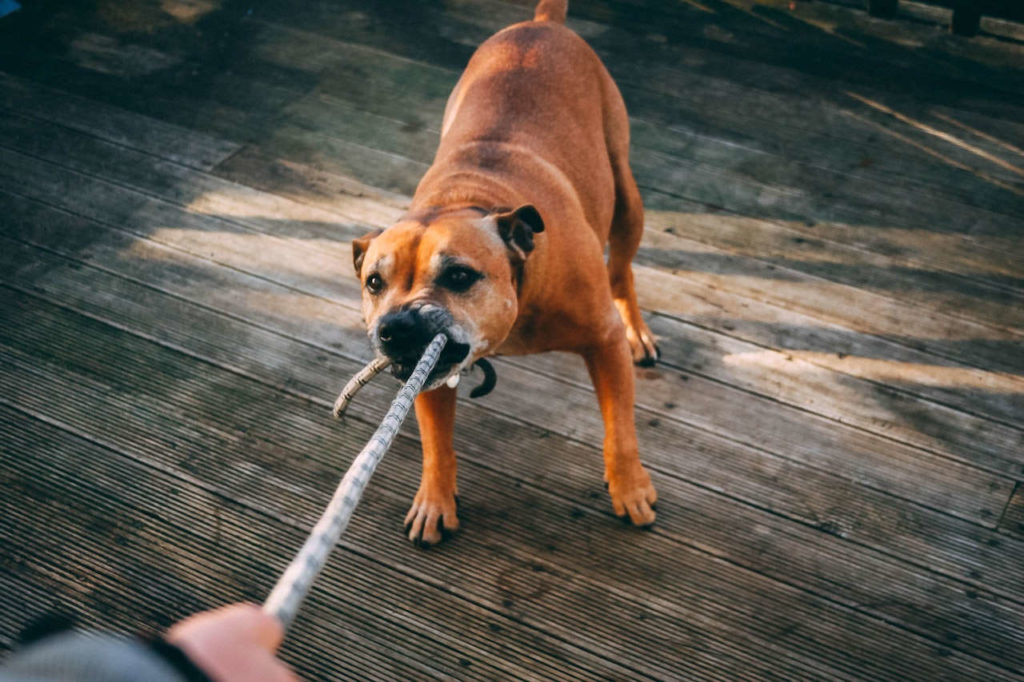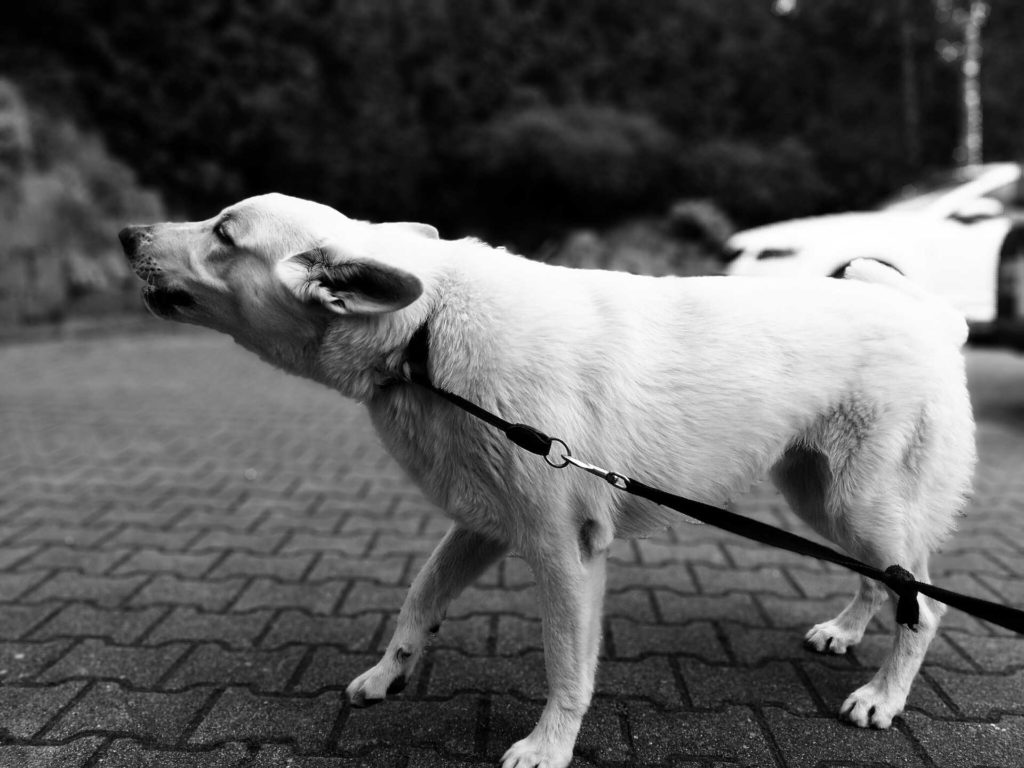
Taking a reactive dog for a walk is one hell of a job.
The second a reactive dog sees another dog or strange-looking object... he’ll start barking, growling, lunging, and pulling in the direction of whatever caught his attention.
For most dog owners with this problem, their dog grows so reactive they prefer walking the dog at odd hours or not take it for a walk at all.
If a reactive dog is not taught how to calm down, their reactive behavior is sure to escalate.
It can get to the stage where owner and dog just sit at home in the hope that another dog doesn’t walk past the window.
Or worse...
The dog’s reactivity becomes so out of control, the only solution is parting ways with an otherwise-lovable four-legged friend.
If this sounds like the unavoidable nightmare you and your dog are heading for, you are not alone.
Thousands of dogs get abandoned to rescues every year or even put down due to aggressive behaviour. More often than not, the truth is your dog is not aggressive - He's simply afraid.
The good news is, there is a cure for fearful dogs.
Whether it's fear of other dogs or fear of humans, this is a resolvable issue.
With appropriate training and behavior modification, you and your furry friend can enjoy the freedom of a pleasant walk together.
But...

Before we can begin to resolve the issue, it's important to understand why your dog is reactive.
Firstly, let's rule out illness and chronic pain. Some dogs -- much like humans -- can suffer from a disease, aching joints and arthritis, especially as they get older. If you have an older canine who has recently become reactive to other dogs, a trip to see the vet might in order.
Arthritis and joint pain in older dogs is usually manageable. With the right treatment, you might find that your dog’s behaviour returns to normal on its own.
Once you’ve ruled out any medical concerns, there are endless reasons why your dog is a reactive dog. The typical case, however, is that your dog feels threatened. By snarling and barking at the thing he finds scary, he is trying to tell the thing (canine or human) to back off and not come any closer.
If your dog is displaying signs of fear by reacting to other dogs, or even other humans, the worst thing you can do is dole out punishments. Aim to support your dog by preventing him from practising reactive behaviour.
For example, plan to exercise your dog in less crowded places or at less busy times of the day. If the sight of another dog is a stress trigger, then turn and walk away. Your dog will not be afraid if it can't see what he's scared of.
Dogs can sense when you’re stressed and anxious.
Most people with a reactive dog will immediately tense the lead and pull the dog towards them at the mere sight of their dog's trigger. By shortening your dog’s lead or pulling him towards you before he's even had a chance to react, will reaffirm his fears.
If you have concerns about not being able to control your dog on a regular lead, then it might be worth investing in a no-pull harness.
When walking your dog, you have to remember that your dog will respond to your energy and demeanor. If you are tense and gripping the lead tightly, this can cause your dog to become agitated and anxious.
Additionally, raising your voice can also escalate ANY situation and make things worse.
Instead, approach the walk with a calm and relaxed attitude. This will make the experience more enjoyable for both you and your dog. You can achieve this by training your dog to walk calmly on leash before taking him to crowded or unfamiliar places.
While on a walk, be mindful of your dog's body language and adjust your own behavior accordingly. If your dog seems anxious or nervous, it can help to slow down your pace and give him some time to sniff and explore his environment.
Overall, walking your dog should be an enjoyable and positive experience for both of you, and by keeping a calm and relaxed attitude, using positive reinforcement and understanding your dog's specific needs will lead to a more enjoyable walk for all.
When you notice your dog getting reactive on a walk, try to redirect his attention to something positive - like a toy or treat.
This way, he has something else to think about besides the thing that scares him. Play mini training games of touch or watch, with regular treats and praise for good behaviour.
Situations like this is where positive reinforcement training comes in handy, especially when teaching your dog to walk calmly on a leash.
3. Change your route.
Keep things interesting for him (and for you!). This is crucial as it ensures that his daily walks remain engaging and stimulating.
One way to do this with a reactive dog is by providing new and varied experiences: if you two have been walking the same path for an extended period, it's likely that your reactive dog (and yourself) have become bored with the routine.
In order to maintain your dog's interest and engagement, it is essential to introduce new sights and smells.
One way to change things up is to explore new neighborhoods or parks, where your dog can discover new sights, smells, and even other dogs to interact with. This not only keeps your dog mentally and physically stimulated, but it also provides you with a new and exciting walking route - I mean, you also want to enjoy walking your dog, right?
Additionally, you could also bring different toys and change the route of your walk during different days, so it'll take him by surprise - which will be interesting for you.
Overall, keeping things interesting for your dog is essential to ensuring that their daily walks remain engaging and stimulating. By introducing new sights, smells, and experiences, you can keep your dog mentally and physically stimulated and make your walks more enjoyable for both you and your dog.
Another way to keep things interesting for your dog is to incorporate training or obedience exercises into your walks. This can include basic commands like sit, stay, come, or heel, or more advanced tricks like rolling over or playing fetch.
By adding an element of training to your walks, you will keep your dog mentally engaged and provide him with a sense of accomplishment.
You can also try walking your dog at different time of the day. This can change the sensation and the ambiance of the place, and also change the way your dog interacts with the environment, making the experience different and unique.
5. Be A Fun Person To Be Around!
Change your pace; speed up and slow down. Walk in circles, weave around lamp posts and trees. Your dog won’t be so worried if his human is fun to be around.
By making the walk more interesting, your dog will enjoy spending time with you.
Sometimes it's best to avoid putting your dog in a stressful situation.
While walking your dog, stay alert! Try to recognize when a situation may be too much for your pet to handle. If you come across an aggressive or overly stimulating dog while out for a walk, it may be best to avoid the encounter for your pet's well-being.
Being proactive and removing your pet from the situation can prevent any potential stress or harm. Your pet may not be able to express gratitude, but they will appreciate your consideration.
Every dog is different and may have unique needs.
Some dogs may require more exercise or a different type of training. Therefore, it is essential to get to know your dog and understand their individual needs to ensure that you are providing the best possible experience for them.
Having said that, owning a reactive dog is frustrating and socially isolating. It can make you feel like a pariah in your own neighbourhood.
As an experienced and qualified dog behaviourist, I can help you to resolve common problems such as reactive behaviour in as little as two comprehensive training sessions. You can start to improve your relationship with your dog today.
Dog Trainer Thailand
2/4 Moo7 Soi 63 Chaoafa Road Chalong Phuket 83130dogtrainerthailand.com © 2023